Media | Articles
When Chrysler wanted “wow” it called Ghia
The idea of show cars arrived in 1939, when General Motors built a car called the Buick Y Job. The Y Job was GM’s attempt at producing an advanced-styled show car. The value in building such cars was to create public exposure for the manufacturers through articles in magazines or newspapers, as well as auto shows and dealerships. The primary purposes were to increase the sales of production cars, to test public reaction, create favorable perceptions of the manufacturer, and to introduce new features.
Then in 1940, Chrysler introduced both the Thunderbolt and Chrysler Newport show cars. Between four and six Thunderbolts were built for display across the country, each painted and trimmed differently. Next, six Chrysler Newport automobiles were designed and built by LeBaron, a well-known Detroit coachbuilder. One Newport actually became the pace car for the 1941 Indianapolis 500. For corporate security reasons as well as costs, Chrysler looked overseas to find a satisfactory coachbuilder. It found that company in Ghia, located in Turin, Italy.
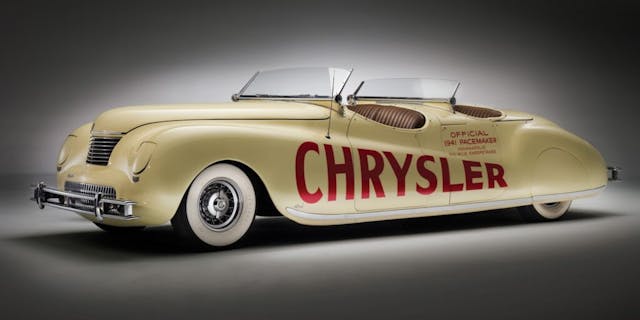
A brief history of Ghia
Scroll back 90-plus years ago and the town of Turin was to coachbuilding as Florence, Italy, was to the Renaissance. Many automotive coachbuilders (carrozzerie) with hammer-wielding skills created car bodies that eclipsed Detroit’s stamped-steel methods. The Italians’ skills were products of centuries of experience going back to the armorers of the Middle Ages. For the carrozzerie, these skills translated into the ability to execute complex metal panels over simple wooden forms with marvelous dexterity of compound curvature and executing beautiful design.
Giacinto Ghia was born on September 18, 1887, and began working at age 15 in a number of small Turin-based carriage/coachbuilders, progressing from woodwork to mechanics to testing of new cars. Shortly after the outbreak of World War I, Ghia joined the Diatto company as a test driver. That ended in 1915 with a crash that broke both his legs.
Ghia then put his early training in carriage/coachbuilding to begin subcontracting to build wooden framework for car bodies for Diatto. By 1918, he had gained a reputation as an excellent body builder. In 1919, Motor Italia described Ghia as “one of the Torinese coach builders whose woodwork bears the imprint of great distinction.” During the late 1930s, Ghia hit its peak production, turning out eight to ten cars a month. This ended at the outbreak of World War II.
Marketplace
Buy and sell classics with confidence
During the war years, Ghia built trailers and carts for the Italian army plus bicycles sold on the black market for the local population for transportation. The Ghia facility was demolished in 1943. Ghia was determined to rebuild but died on February 21, 1944. He was only 56.
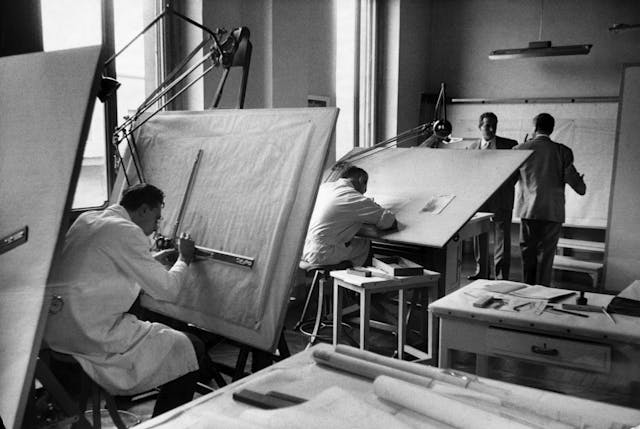
Chrysler makes the Italian connection
In 1949, K. T. Keller, president of Chrysler realized that the lackluster styling of the company’s cars was an issue. The company’s conservative styling was becoming a trademark in the industry and sales were dropping. Ford passed Chrysler in sales in 1952 and the company had a 12-percent market share in 1954. Other automakers were beginning to make good use of curved-glass windshields, slab-side styling, flattened hoods and fender lines, plus sleek styling.
To begin to address the challenges, Chrysler contacted Ghia and one of its Italian competitors, carrozzeria Pinin Farina, to discuss building a car. In early 1949, Chrysler sent a Plymouth chassis to each coachbuilder; the Ghia car received a more favorable response. Keller was sufficiently impressed by Ghia’s design, craftsmanship, and certainly the moderate cost of only $10,000. Interestingly, in 1949 as well, Kaufman had hired a stylist, Virgil Exner, to revive Chrysler’s design image. Exner was not hired as the overall head of styling (that would occur in the mid-1950s), but mainly as a catalyst who was given a small staff and work area to design and arrange production with Ghia of one-off Chrysler “Idea Cars.”
Keller’s plan, which Exner supported, was to build not radical, futuristic-looking styling exercises, but cars that were fully functional. The purpose was to test public reaction, but more important, help change perception (of both the public and the company’s financial backers) that Chrysler really cared about contemporary styling and what the public could expect in the near future. Exner established the Advanced Styling Group; this group and the new collaboration with Ghia were the main forces in the creation of Chrysler’s Idea Cars.
The first Exner-designed show car was produced in late 1951 by Ghia and marked the initial beginning of the Idea Car Program. The car was called the K-310; the “K” was in honor of K. T. Keller. The K-310 was a two-door, four-passenger hardtop with a 331-cubic inch Hemi engine. It was painted blue and black and had a big eggcrate grill. It reflected Exner’s design philosophy, which he had promoted since his days with Studebaker: simple classic surfaces accentuated the functional elements of the car, rather than hiding them.

Exner insisted that all the show cars be designed as practical roadgoing automobiles, not simply static show cars like the General Motors Motorama specials. He also decreed that all vehicles be made from steel, although the Italians preferred aluminum. The K-310 was followed by the Chrysler C-200 convertible. Both cars have yet to be rediscovered and may no longer exist today.
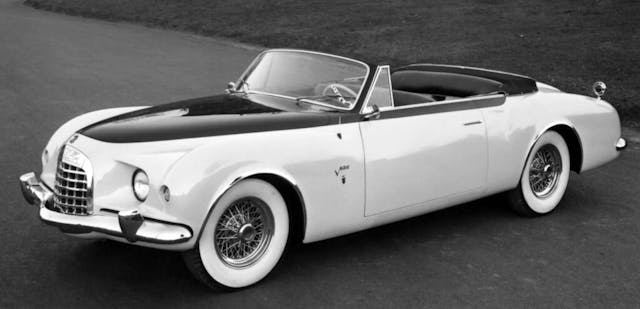
In late 1952, Ghia built for Chrysler a car designed by Virgil Exner that was known as the Chrysler “Styling Special,” which is on the field today. This car, known as the Fastback design, was the only example built. Later in 1953, Chrysler built a similarly shaped body with a few other changes that it called the “Thomas Special,” named for Chrysler’s vice president of export sales, J. B. Thomas. Experts estimate that 12 of the 18 examples built still exist today—truly a limited-production car. The Chrysler Styling Special could be considered the father of the Thomas Special.
Then in 1954, a somewhat redesigned Thomas Special was built, called the Chrysler GS-1. Approximately 10 to 12 of these were built. None of the three phases of similarly designed cars were sold to dealers or purchased by individuals. Instead, they usually were given to world leaders, very important people, or members of Chrysler’s Board of Directors. The last version—the GS-1—was only sold in Europe by the Société France Motors, Chrysler’s distributor for France. Approximately eight GS-1s still exist. The Styling Special on the field today was the first version that influenced the very limited number of Thomas Specials and GS-1s made.
Exner was involved with all the Ghia-designed idea cars, including the 1961 XNR and the 1962 Chrysler Turbine car. Rising to vice president of styling in 1956, he left Chrysler in 1961. He died on December 22, 1973, at just 65 years old. During his tenure, Exner worked with Ghia to design and produce some of the most amazing cars ever to come out of Chrysler, and today we honor that achievement.
Ghia Concepts is one of 20 classes to be featured at the 2023 Greenwich Concours d’Elegance, on June 2-4, 2023. Download the 2023 Greenwich Concours d’Elegance event program to learn more about Sunday’s other featured classes, Saturday’s Concours de Sport, our judges, sponsors, non-profit partners, 2022 winners and more!
***
Check out the Hagerty Media homepage so you don’t miss a single story, or better yet, bookmark it. To get our best stories delivered right to your inbox, subscribe to our newsletters.
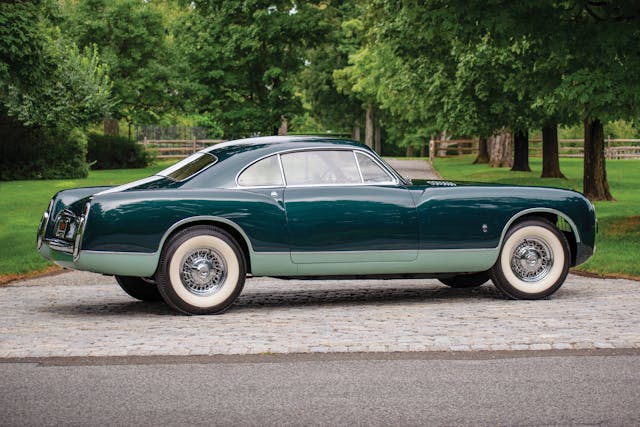





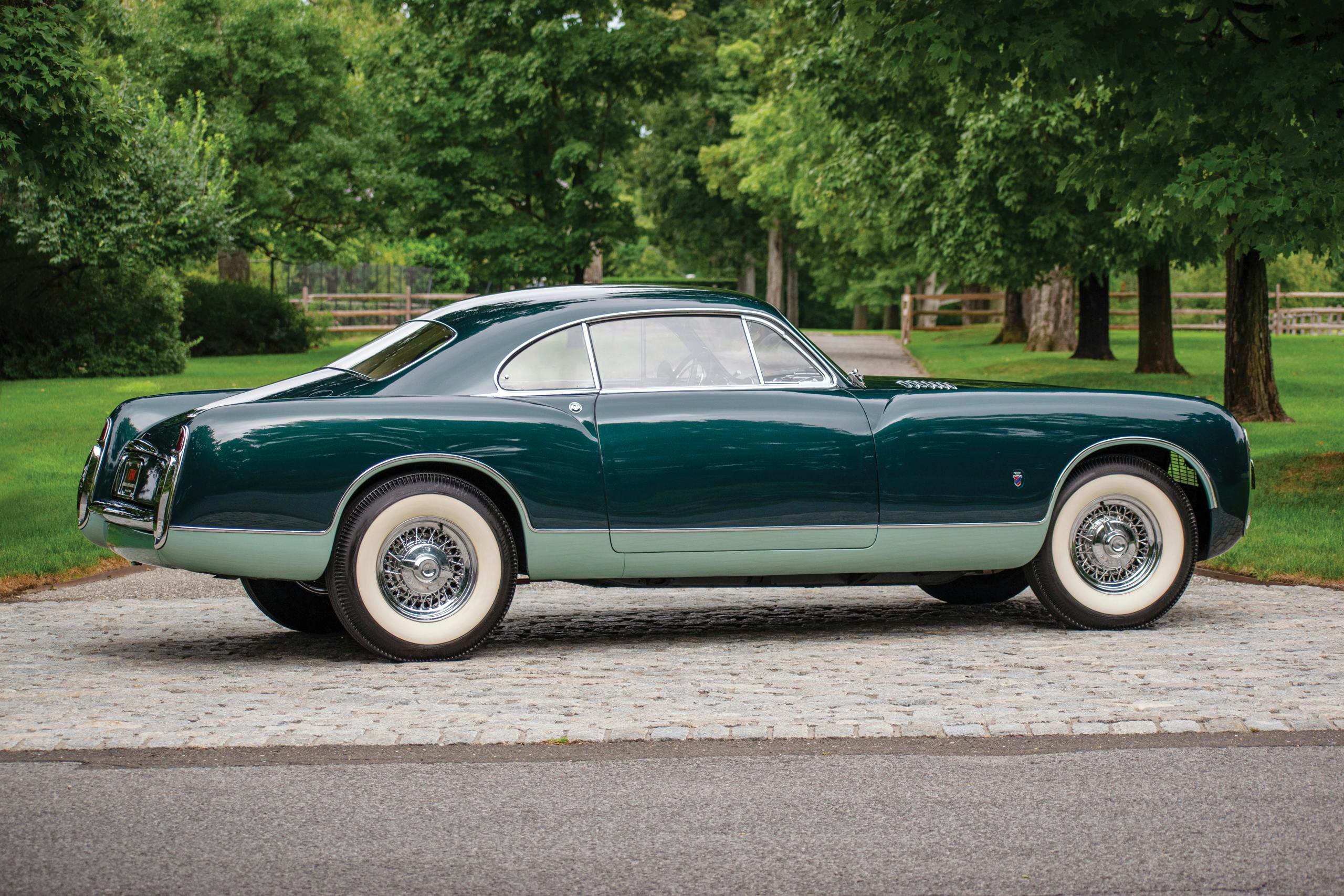
I am not a Chrysler guy but if they had really gone more this direction I may have been a Chrysler guy today.
These cars are works of art. While some styling was shared with the production cars it just was not enough to capture the full effect these cars had.
Nice article but should have mentioned the Chrysler Norseman
Would be nice to see pictures of more of the cars in the article.
Fantastic amount of fascinating and necessary historical info!
Surely, one of your best “History” articles.
I GOTTA say — that first photo grabbed me like very few ever have…
The Continental Mk II was a design that was just so SIMPLY perfect: classic, classy, clean and eternal.
This Chrysler model took that one or two levels higher.
It “rounded” the form, giving a certain soft, aerodynamic; yet yielding nothing in its sheer beauty.
My God — it’s been such a long time since I’ve looked at a car, and thought anew: “THAT’S my dream car!”
A dream refreshed.
I agree. I miss the times when Chrysler was an ‘engineers’ car. But then again I miss wind wings, windows that had rain gutters and a dimmer switch on the floor where God intended it to be. Lol
Since you’re mentioning classic, eternal and clean designs, l’d like to mention the 1953 Studebaker Starliner .
So elegant, and perfectly proportioned!
My dad grew up in this era. He drove only Chryslers, except for the supercharged Duesenberg and the Jaguars. Thanks for the memories.
Chysler if only, they had good management, what could of been
My grandfather was a Chrysler man until the day he took the car out “to have the oil changed.” They found him three days later halfway across the State with no idea how he got there. The family took his keys away and sold the car.
IF Chrysler wanted to build a “retro styled ” car again ………look no further than that !! It even has the “muscle ” look with short rear deck and long front hood….. !!!
And now they are owned by Ghia.
The Chrysler Ghia’s are very interesting cars. It would have been interesting to see what could have been if they had been the styling house for Chrysler.
Yea, more pictures of the ones mentioned
Chrysler execs visiting Ghia’s facilities in Italy were amazed to see teenage boys hammering sheet steel over tree stumps. The Chrysler C-200 (and ’34 Packard Twelve Model 1106 Lebaron sport coupe) my dream car in college. Clean, understated styling is the package for sound engineering. Chrysler’s achingly conservative styling understandable after the unattractive Airflow, which nonetheless had the strongest, safest body of any automobile of the ’30s.
As the others above suggest, the K-310 and C-200 are clean, timeless design. Unfortunately, later in the ’50s, domestic car styling became a joke of tri-colored, befinned, chrome baroque even as network TV such a morass that by 1961, FCC Chair Newton Minow summed it “a vast wasteland.”
Industry polls in the ’50s showed Chryslers the choice of educated professionals; engineers, tenured professors, architects able to see beneath an industry-wide glitz of fins and portholes. Given later well-engineered boxy sedans from Stuttgart, 1951-54 Chryslers were ahead of their time. Chrysler’s Oriflow shocks, patented two-leading-shoe front brakes controlled a road car balanced front and rear, a ’53 hemi New Yorker having a more nimble 16.2:1 steering gear against Cadillac’s clumsy 25.5:1, with as much horsepower from the same displacement using regular gas, the Dagmar-mobile requiring premium.
Unfortunately, the downsized 1953-54 Chryslers were box office poison against Harley Earl’s silly GMobiles.
Nice article, but the others are right. Could’ve used more photos. Thanks.
The cover car has a lot of Facel Vega styling cues. I believe with their superior hemi engines, what evolved quickly to a bullet proof automatic and more European style Chrysler could have dominated the 50’s and 60’s if they had the marketing to back it up
I was reading your article, “When Chrysler wanted “wow” it called Ghia” when all of a sudden I read “Kaufman had hired a stylist.” Who’s Kaufman? Surprise! It’s K. T. Kellar. Provide a little more information before you spring a name on the reader. Thank you for the educational reading.
I would love to see an article about the 1961 XNR. Virgil Exner liked it so much he named it after it after his favorite person.